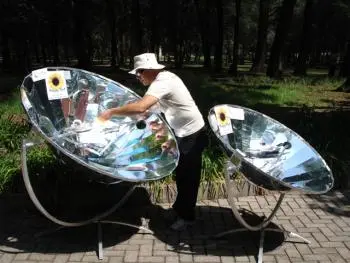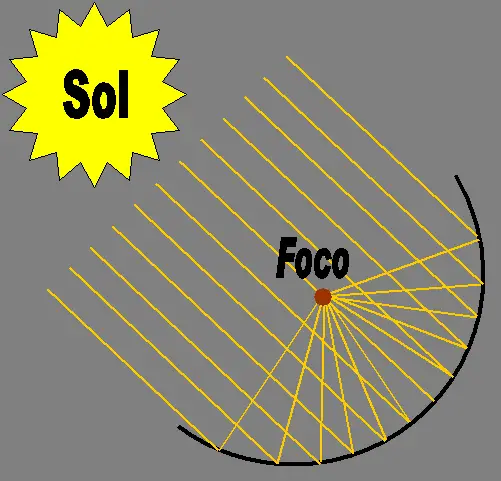
A solar cooker is an example of using solar thermal energy designed to cook food. This technology has been present in human history for centuries, but has gained renewed interest in recent decades due to its potential to address the challenges of sustainability and energy conservation.
In this article, we will explain in detail what solar cookers are, their operation, advantages and disadvantages along with indicative tables on their cooking times and prices.
What is a solar cooker?
A solar cooker, also known as a solar oven or solar cooker, is a device that uses the sun's energy to heat and cook food, as well as perform tasks that require heat.
It works by taking advantage of direct solar radiation, which is concentrated and converted into usable heat. Unlike conventional cookers that use electricity, gas or wood, solar cookers are an ecological and sustainable option, since they do not emit carbon emissions or consume non-renewable resources.
Operation and types of solar cookers
Solar cookers work by harnessing the sun's energy to cook food or heat water. There are several types of solar cookers, but they all share a basic principle: concentrating and converting sunlight into usable heat.
 The main types of solar cookers are:
The main types of solar cookers are:
- Box solar cookers : These cookers are the simplest and most economical. They consist of an insulated box with a glass lid that allows sunlight to enter and be trapped inside. At the bottom of the box, a pot or pan with food is placed. Sunlight is concentrated inside the box and heats the food.
- Parabolic solar cookers : These cookers use curved mirrors to concentrate sunlight on a focal point, where the pot or container with food is located. The mirrors follow the movement of the sun during the day to maximize energy harvesting.
- Hybrid solar cookers : They combine solar energy with other energy sources, such as electricity or gas, to ensure a constant supply of heat. This makes them more versatile and suitable for use in situations where sunlight is intermittent.
Advantages
Solar cookers offer numerous advantages that make them an attractive option:
- Sustainability: Solar energy is inexhaustible and produces no carbon emissions. Using solar cookers helps reduce the carbon footprint and mitigate climate change.
- Energy Savings: Solar stoves do not require fossil fuels or electricity, resulting in significant savings on your energy bill in the long term.
- Accessibility: They are especially useful in rural or remote areas where access to the electrical grid or reliable fuel sources is not available.
- Food Safety: In the event of natural disasters or emergency situations, solar cookers can provide a reliable source of cooking without relying on external supplies.
- Public health: By eliminating the need to cook over open fires or wood stoves, exposure to toxic fumes is reduced and the health of communities is improved.
Disadvantages
Despite their advantages, solar cookers also face some challenges:
- Dependence on weather conditions: Solar cookers are less effective on cloudy or rainy days and are not practical at night. This requires planning and the possibility of having an alternative energy source.
- Space Requirement: Larger solar cookers, such as satellite dishes, require additional space, which can limit their use in densely populated urban areas.
- Learning and training: To get the most out of solar cookers, users need training and knowledge about how they work.
- Durability and maintenance: Ensuring that solar cookers continue to operate efficiently over time requires regular maintenance and, in some cases, component replacement.
Indicative cooking times
Below we present a table of cooking times for example foods in solar cookers and conventional gas cookers. Please note that times may vary depending on the type of solar cooker and weather conditions.
Cooking times on a solar cooker may be longer than on a gas cooker due to the dependence on sunlight. These are just general examples:
|
Food |
Solar cooker |
Conventional gas cooker |
|
Rice (2 cups) |
1.5 - 2 hours |
15-20 minutes |
|
Beans (1 cup) |
3-4 hours |
1-1.5 hours |
|
Steamed vegetables |
45 minutes - 1 hour |
15-20 minutes |
|
Chicken (breast) |
2-3 hours |
20-25 minutes |
|
Lentil soup |
2.5 - 3.5 hours |
1.5 - 2 hours |
|
Fish (fillet) |
1-2 hours |
10-15 minutes |
|
Hard boiled eggs (4) |
2-2.5 hours |
10-12 minutes |
|
Bread (small) |
2-3 hours |
20-25 minutes |
|
Cakes (small) |
1.5 - 2.5 hours |
25-35 minutes |
Solar cookers are ideal for recipes that require a longer cooking time, such as soups, stews, and legumes. For recipes that require quick cooking, such as stir-frying or frying, a conventional gas stove is usually more efficient.
Indicative prices
Solar cooker prices vary widely depending on type, size, quality, and additional features.
Here is a table with indicative prices for some common types of cookers:
| Type of solar cooker | Price in USD (approximate) | Price in EUR (approximate) |
|---|---|---|
| Box Solar Cooker | $30 - $150 | €25 - €125 |
| Parabolic Solar Cooker | $150 - $500 | €125 - €420 |
| Hybrid Solar Cooker (with battery) | $200 - $800 | €170 - €670 |
| Portable Solar Cooker | $20 - $100 | €17 - €85 |
These prices are only a rough guide and may vary depending on the brand, build quality and specific features of each model. Portable solar cookers tend to be the most affordable, while parabolic dish solar cookers tend to be more expensive due to their greater heat concentration capacity.
In addition to the initial purchase cost, keep in mind that solar cookers have very low operating costs since they use free solar energy. This can result in long-term savings, especially in areas with limited access to conventional energy sources or high energy costs.